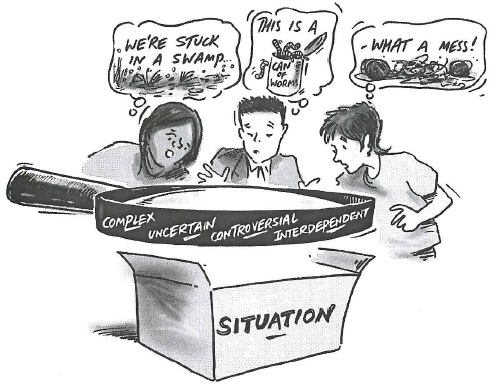2 Distinctions between rational and emotional reactions to situations
Conventionally, it is assumed that top people deal with the most serious situations and lowly staff deal with trivial ones. This is only true if the term ‘problem’ (which is the most common word we use for situations) is defined in a way that simply mirrors the different responsibilities of senior and junior positions, whether that be at work or at home. Further, whatever the position someone takes on a problem there is a tendency to focus on the rational aspects and leave aside, or even deliberately ignore, the emotional aspects of the situation. These aspects are discussed by Colin Eden and colleagues (1983):
We can usually give some sort of an answer to the question ‘What is the problem?’, but it may not be an answer that convinces us, and we often feel we have only been able to give a rather limited description. So it is quite common that the only descriptions we can find for problems are, without any way being intended as lies, not descriptions that we feel contain the most important truths about our problems.
Now this is a common feature of the experience of many people, that the step between feeling some sort of discomfort or dissatisfaction, feeling that there is some problem somewhere, and being able to say ‘The problem is such-and-such’ is a very big step. In fact quite often we find that if we can say what the problem is we have gone a long way towards solving it. This seems to be true with any kind of problem, whether it be some technically-oriented work problem, a relationship problem at home or anything in between.
One of the properties of problems with which helpers have found it quite hard to grapple is the extent to which all problems are personal; different persons see different problems in what other people would take to be the same situation. This is an important point in our argument, and is fairly well accepted in everyday ‘common sense’. This point does not seem to raise much difficulty when it is expressed theoretically, but it is often rather more difficult to bear it in mind and act upon in practice.

For practical purposes it is essential to remember that both the rational and the emotional aspects are important in comprehending a messy situation.
Activity 3 Emotional and rational aspects of situations
Turn back to your notes on messy situations from Activities 1 and 2. Add to them by considering the following questions:
- What ways were ‘interpersonal relationships’ (i.e. personal evaluations, likes and dislikes) a contributing factor in the situation as you saw it?
- How do you imagine the other people involved saw the situation - and saw you?
- What ‘political concerns’ were a contributing factor in the way that you saw the situation?
- What political concerns do you attribute to the other people involved? Were their concerns ‘legitimate’? Were yours?
- Were there multiple causes for any of the situations you listed earlier and what were they? How far does this help explain some of the disagreements?
- What important considerations in your messy situations could not be adequately represented in terms of hard information and demonstrable facts?
Comment
In summary, difficulties and messes are broad terms and the distinction between them is not clear-cut and categorical. Rather they provide the opposite ends of a continuum, with many problems lying somewhere in between. The attributes that distinguish between difficulties and messes concern their scale and the uncertainty associated with them. There are also elements of rational and emotional complexity to be considered. Although no single characteristic provides an essential criterion, to describe a situation as messy, rather than just a difficulty, implies that in some important respects it is unbounded.
